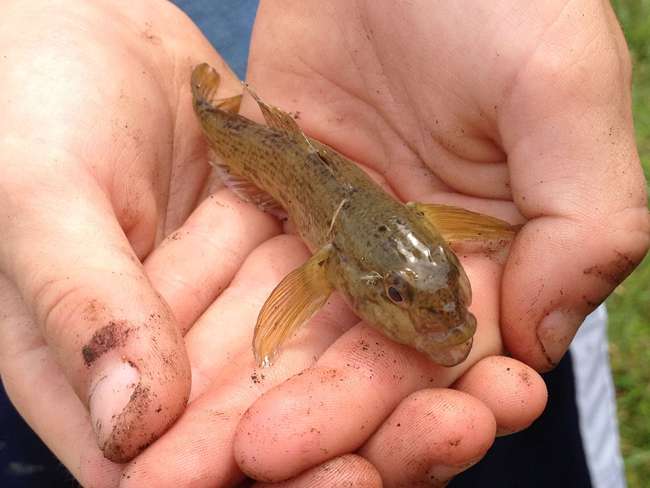By New York Sea Grant Launch Steward Britney Rogers
New York Sea Grant 2013 Launch Stewards Program
Contacts:
Mary Penney, NY Sea Grant, E:
mp357@cornell.edu, P:315-312-3042
Kara Lynn Dunn, Publicist, E:
karalynn@gisco.net, P: 315-465-7578
Oswego, NY, September 6, 2013 - If you are among the anglers who enjoy fishing on the Great Lakes, have you ever caught something you had never seen before? If you answer yes, you are not alone. More than 180 aquatic invasive species (AIS) in the Great Lakes are disrupting food webs, degrading aquatic habitats, and displacing native species. Do you know what to do if you find an AIS at the end of your fishing line?
To limit and, in some cases, prevent the spread of AIS and protect the health of popular fishing spots and recreational waterways, it is important for the public to be able to accurately identify and report AIS. Once AIS have become established, it is more difficult to remove or manage them, which is why tracking their distribution range is vital for early detection and controlling the spread of the unwanted species.

This round goby, an AIS, was not what an angler hoped to hook on
a recent Lake Ontario fishing trip.
Photo: NYSG Launch Steward Megan
Pistolese
The first step after encountering what you think may be an AIS is to try to properly identify the species. The
New York Invasive Species Clearinghouse is a useful tool to help you distinguish between AIS and native lookalikes. To help you identify your ‘catch,’ the Clearinghouse website consists of photos, species-specific characteristics (size, color, etc.), range, and tips for limiting AIS spread.
If you cannot confidently identify your ‘catch,’ a sample of the species can be delivered to your local Partnership for Regional Invasive Species Management (PRISM) representative for identification. Contacts for local PRISMs can be found at
www.nyis.info.
When collecting samples, be sure to seal the specimen in an airtight package, e.g., a sealable plastic bag, and include the date; the location, including GPS coordinates; and your name and contact information.
Terrestrial and aquatic invasive species observations can be reported to New York’s online database
iMapInvasives, managed by the NYS Natural Heritage Program. This tool is user-friendly and field-ready with a smartphone application.
To upload data to
iMapInvasives, you must receive a username that is generated when you attend a free training session, typically offered by PRISMs in the spring.
After completing training you are ready to begin adding your observational data to the
iMapInvasives database. The site provides step-by-step instructions and currently has six different data forms for use: observation, assessment, survey, treatment, infestations, and projects. The site also has species distribution maps, tables, and reports by species/areas.
If possible, take a well-focused, up-close photograph of the species and of the habitat where the species was found. The photograph can be sent electronically to local experts and may be needed for archiving purposes. Photographs are also suggested as collected specimens can lose their color.
Once iMapInvasive/PRISM experts receive a reported finding, they will confirm or correct the sighting using the specimen, photographs, and/or site visits.
The confirmed observational data provided by citizens help PRISM partners develop and implement management strategies for AIS.
Through species identification and iMapInvasives training, you and natural resource managers gain knowledge about which areas/habitats are at greatest risk of invasion, which species pose the greatest threats, and which areas are the most pristine so you can implement preventative practices to help keep these areas clean of AIS.
It’s not too late to make a difference in the fight against AIS. For more information on protecting native habitats against invasive threats, contact New York Sea Grant at 315-312-3042,
SGOswego@cornell.edu. To learn more about the NYSG Launch Steward Program, visit
nysglaunchsteward.blogspot.com.
This is the fifth in a series of articles by the 2013 New York Sea Grant Launch Stewards. The stewards are college students educating water users about how they can help slow the spread of aquatic invasive species as part of a statewide effort. Learn more online at
www.nyseagrant.org/ccd.
More Info:
New York Sea Grant (NYSG), a cooperative program of Cornell University
and the State University of New York, is one of 33 university-based
programs under the National Sea Grant College Program (NSGCP) of the
National Oceanic and Atmospheric Administration (NOAA). The NSGCP
engages this network of the nation’s top universities in conducting
scientific research, education, training and extension projects designed
to foster science-based decisions about the use and conservation of our
aquatic resources. Through its statewide network of integrated
services, NYSG has been promoting coastal vitality, environmental
sustainability, and citizen awareness about the State’s marine and Great
Lakes resources since 1971.
For updates on Sea Grant activities:
www.nyseagrant.org has RSS,
Facebook,
Twitter, and
YouTube links. NYSG also offers a free e-list sign up via
www.nyseagrant.org/coastlines for NY Coastlines, its flagship publication, and Currents, its e-newsletter supplement, each distributed several times a year.